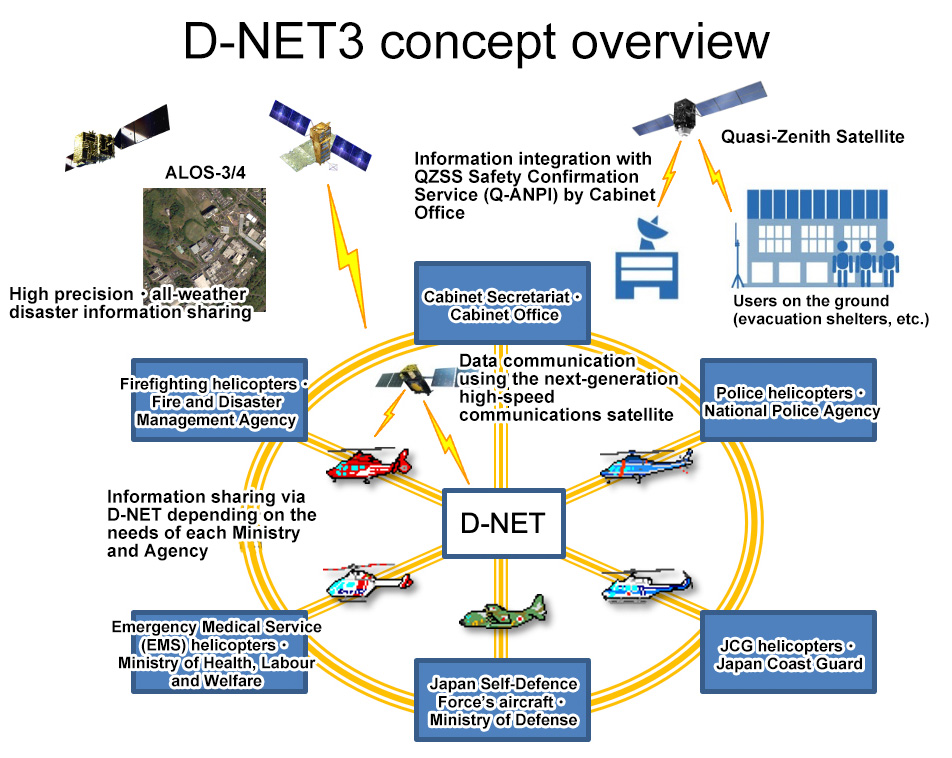Research & Development
JAXA promotes three research and development programs and a fundamental research program that underpins them.
Integrated operation system for disaster relief and crisis management (D-NET3) (FY2018-)
To enable safer and more efficient disaster relief aircraft operations, JAXA has been developing “Disaster Relief Aircraft Management System(D-NET)” , which facilitates real-time information sharing among aircraft involved in relief activities and emergency operation centers on the ground.
D-NET started as “Disaster Relief Aircraft Information Sharing Network ”, part of the DREAMS project (FY2012-FY2015). In FY2013, work started on the "Integrated aircraft operation system for disaster relief (D-NET2)", which integrates the operation of manned aircraft, unmanned aerial vehicles and satellites, and optimizes allocation of available resources in order to improve the speed and efficiency of relief operations. D-NET2 has since been used in actual disaster response such as the Kumamoto Earthquake in April 2016 and the Northern Kyushu heavy rain in July 2017.
Since FY2018, research and development of the "Integrated operation system for disaster relief and crisis management (D-NET3)" has proceeded. D-NET3 will expand further its capabilities to enable coordinated response in crises not limited to natural disasters. Our ongoing challenge is to further enhance and facilitate the use of D-NET 3 by collaborating with various stakeholders, including the relevant ministries, agencies, and local governments who are directly involved in disaster response.

D-NET3 enhanced functions
Flight plan modification function
Flight planning and coordination used to be done manually based on information sent by fax and phone, for example, which would cause mistakes and complicate flight operations.
D-NET3’s capabilities enable visualization of flight routes of multiple aircraft operated by different organizations, which helps operators to identify and avoid any possible flight route conflicts. This function was developed based on D-NET’s data standard allowing the transmission and reception of standardized dataset efficiently as digital data. D-NET3 enables real-time confirmation and modification of flight plans in both pre-flight and in-flight phases, reducing the time required for flight coordination and improving the situational awareness of flight operators thus minimizing human errors.
Position monitoring function with PSSR
With this new capability, aircraft not equipped with D-NET’s onboard systems can share their position data by using an existing “Passive Secondary Surveillance Radar (PSSR)” so that they can be managed centrally in D-NET. At present, this function allows D-NET to monitor non-D-NET equipped helicopters flying at low altitude.
Disaster relief aircraft operation technology (D-NET2 between FY2013 and FY2018)
JAXA had been working on the research and development of the “Integrated Aircraft Operation System for Disaster Relief (D-NET2)”, which assists collection and sharing of disaster information through the integrated operation of manned aircraft, unmanned aerial vehicles (UAV) and satellites, for efficient and safe rescue operations by disaster relief aircraft.
Aircraft operation technology for disaster relief (D-NET between FY2012 and FY2015)
D-NET was initially developed as part of DREAMS project’s Aircraft operation technology for disaster relief. Major objectives were to optimize operations and reduce rescue aircraft near-misses during missions, and to improve efficiency and safety by sharing necessary information among rescue aircraft and relief headquarters.